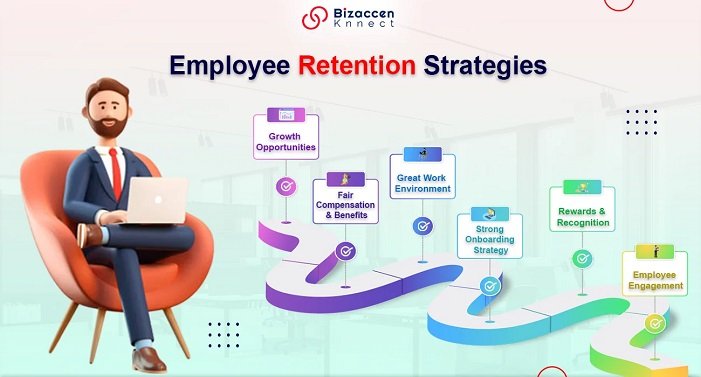Keeping talented employees onboard is essential for sustainable growth. Having worked on various employee retention strategies, I’ve seen firsthand how the right approach can dramatically improve morale, productivity, and loyalty. Below, I’ll share the most effective strategies that have worked in my experience—these tactics can help you build a committed, motivated team that drives long-term success.
1. Create a Positive Company Culture
A strong company culture is one of the most critical aspects of employee retention. When team members feel connected to the organization’s values and vision, they’re more likely to stay and perform at their best. Here’s what I’ve found most effective in fostering a positive culture:
- Define Core Values: Be clear about your mission, values, and goals, and make sure they align with the team’s values.
- Encourage Open Communication: Regularly gather feedback and address concerns. This creates trust and demonstrates that you value your employees’ opinions.
- Celebrate Successes: Acknowledge achievements—whether big or small. Recognition boosts morale and shows employees that their contributions matter.
2. Offer Opportunities for Professional Development
Investing in your employees’ growth is a powerful-ways-nguyen-si-kha-someone-like-you-2022/ul way to build loyalty. In my experience, people are far more likely to stay if they see a clear path for growth within the company. Here are some ways to support your team’s development:
- Provide Training Programs: Fund workshops, courses, or certifications that help employees advance in their careers.
- Promote from Within: When possible, give current employees the opportunity to step into new roles before looking externally.
- Offer Mentorship Programs: Pair less experienced employees with seasoned team members to foster growth and strengthen relationships.
3. Offer Competitive Compensation and Benefits
Compensation isn’t everything, but it is a crucial factor in employee satisfaction. Competitive salaries, combined with a comprehensive benefits package, can make a significant difference in retention. Consider these points:
- Benchmark Salaries: Regularly compare your salaries with industry standards to ensure they’re competitive.
- Health and Wellness Benefits: Offer health insurance, retirement plans, and other benefits that show you care about employees’ long-term well-being.
- Flexible Work Options: Allowing remote work, flexible hours, or hybrid schedules can increase job satisfaction and reduce burnout.
4. Foster Work-Life Balance
Maintaining a healthy work-life balance is essential for employee satisfaction and well-being. I’ve seen retention improve significantly when teams have flexibility in their schedules and aren’t constantly pushed to the limit. Here are some strategies:
- Set Realistic Expectations: Encourage managers to set achievable goals and avoid excessive workloads.
- Promote Paid Time Off: Make sure employees feel comfortable taking time off to recharge.
- Encourage Flexibility: Whenever possible, offer flexible schedules or remote work options. This demonstrates trust and respect for employees’ lives outside of work.
5. Recognize and Reward Employees
Showing appreciation goes a long way in making employees feel valued and committed to their work. In my experience, meaningful recognition can be just as impactful as monetary rewards. Consider these ideas:
- Public Acknowledgment: Recognize accomplishments in team meetings or company-wide updates.
- Small but Thoughtful Rewards: Bonuses, gift cards, or extra time off can show employees you appreciate their hard work.
- Create an Employee Recognition Program: Implement a system where team members can nominate peers for outstanding performance. This boosts morale and builds a culture of appreciation.
6. Conduct Regular Feedback Sessions
Consistent feedback not only helps employees improve but also keeps them engaged. Conducting feedback sessions is a key component of my retention strategy, as it provides insight into how employees feel about their work and the organization.
- One-on-One Meetings: Regular check-ins with managers allow employees to share concerns and receive constructive feedback.
- Performance Reviews: Conduct formal reviews at least twice a year to set goals and assess progress.
- Anonymous Surveys: Use anonymous feedback tools to get honest input on company policies, culture, and management.
7. Build a Path for Advancement
Creating opportunities for career growth is critical for retaining ambitious employees. Many people leave jobs because they feel there’s no room for advancement. To address this:
- Offer Clear Promotion Paths: Define the qualifications for each position and share these paths openly with the team.
- Encourage Skill Development: Help employees gain the skills needed to advance in their careers.
- Celebrate Internal Mobility: When someone gets promoted, share their story within the company. This not only motivates others but also strengthens the sense of belonging.
Final Thoughts: Employee Retention as an Ongoing Effort
Employee retention isn’t a one-time fix; it requires consistent effort and adaptation. By creating a supportive environment, offering development opportunities, and recognizing hard work, you’ll be well on your way to building a loyal team that fuels your business’s success.
These strategies have worked well in my experience, and I believe they can make a meaningful difference in your organization too. The key is to remain flexible, listen to your team, and always be willing to adjust based on their needs.

